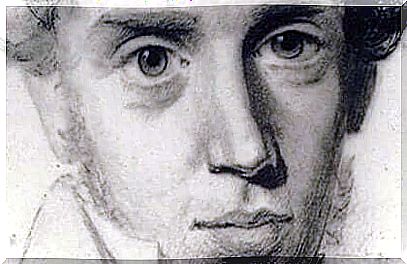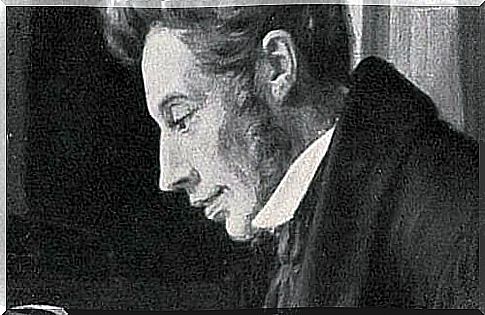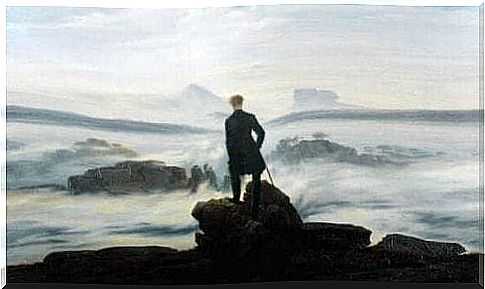Søren Kierkegaard: The Father Of Existentialism

They say that Søren Kierkegaard loved his beloved Regina Olsen until his last day. His life purpose, however, was to devote his whole body and soul to philosophy and the Christian faith.
This Danish theologian and philosopher had to live with the pain of not being able to be with his loved one. However, this enabled him to build a remarkable legacy.
The work of Kierkegaard is based primarily on faith. According to him, it is only possible to achieve salvation and balance in times of despair through faith.
This perspective was a reaction to Hegel’s idealism. In fact, what characterized this famous Danish philosopher was his critique of the religious institutions he believed to be hypocritical.
The dualism that shaped his entire life is quite evident in his books Fear and Trembling , Philosophical Fragments, and Diary of a Seducer . Love, suffering and impossible passion, in relation to the necessary need to devote himself to theology, characterize the arduous journey which one of the most relevant and interesting philosophers has had to undertake.
While the Danish Church suggested that there was a rational God who rewarded good deeds , Kierkegaard’s God cared not about devotion, but about fear.
His philosophy formed the basis of existentialism of the twentieth century. He defined human subjectivity and also inspired other great thinkers such as Jean-Paul Sartre, Friedrich Nietzsche and Albert Camus.

Biography of Søren Kierkegaard
Søren Kierkegaard was born in Copenhagen in 1813 to a wealthy family. His father was Michael Pedersen Kierkegaard, a very religious wool merchant with a conservative view of human existence.
His mother was Anne Sorensdatter Lund Kierkegaard, a young servant who became pregnant by his father. This fact made him feel like he was the product of a sinful act.
Young Søren attended the School of Civic Virtue and then studied theology at the University of Copenhagen. However, it is worth mentioning that he was mainly interested in philosophy and literature.
A very significant moment in his childhood was when he met 15-year-old Regina Olsen, who he became engaged to after graduating from college. However, just before his father died in 1838, he made Søren promise that he would become a pastor and that he would dedicate his life to God and to his studies.
This promise weighed so heavily on him that it inevitably disrupted his love life. He broke off his engagement to Regina and then moved to Berlin. The next ten years were the most productive years of his life.
Love, Guilt and Suffering
In 1843 he published six of his works. One of these works was Fear and Trembling , in which he describes in detail a subject that he continues to talk about in his later works: his love for Regina. In this particular work, he explores his guilt, pain, and devotion to faith.
That same year, he also returned to Copenhagen and found out that Regina had just married Frederik Schlegel. This marriage has completely ruined the possibility of a second chance for their love.

Some of his most notable books are Philosophical Fragments , The concept of anxiety, and Stages on life’s way . These books are mainly about the thoughts and realities that a person experiences when confronted with adversity.
Søren Kierkegaard’s family has endured many tragedies, leaving ultimately only him and his brother Peter.
Their father always reminded them that they were cursed, that they were doomed to live in the shadow of sin and that they would all die young. Unfortunately, this ‘prediction’ has also come true: Kierkegaard died when he was 42 years old.
However, the cause of his death was never fully understood. Not only did he suffer from some kind of disability, but he also suffered from a lot of other health problems. Fortunately, however, this has never stopped him from leaving the world an exceptional literary and philosophical legacy.
In his last time here on earth, he decided to include Regina in his will, another detail that shows us how deep his love for her ran.
The Legacy of Søren Kierkegaard
William James often liked to quote Søren Kierkegaard: “Life can only be understood backwards; but it must be lived forward.” Kierkegaard was the Danish philosopher and theologian of subjectivity.
He taught the world that to live you need to know how to make the right choices. With every choice we make, we shape our lives and define who we are and what we leave behind.
Kierkegaard also worked very hard to help people understand the sense of fear and suffering. Fear and suffering are both part of life. And according to Kierkegaard , the only way to relieve the pain they caused was faith.

Pseudonyms and existentialism
Søren Kierkegaard wrote most of his works under various pseudonyms, such as Victor Eremita, Johannes de Silentio, Anti-Climacus, Hilarius Bookbinder or Vigilius Haufniensis. He used these pseudonyms for a very concrete purpose, which is to represent different ways of thinking.
This strategy defined what he called “indirect communication.” By using pseudonyms, he was able to explore other points of view. At the same time, one of Kierkegaard’s goals was to find a way to teach people to live. Therefore he established three planes of existence:
- First of all, we have the aesthetic area. This area represents a way of life based on pleasure, hedonism or nihilism.
- Second, there is the ethical area. This is when the individual is able to be responsible for themselves. In this area one must be able to discern right from wrong and act accordingly.
- And last we have the religious area. This area has the highest position in Kierkegaard’s hierarchy. Indeed, this is the area where people establish a personal relationship with God, enabling them to achieve the noblest of goals.
The philosopher of fear, the philosopher of irony
People like Albert Camus called Søren Kierkegaard the philosopher of irony. Kierkegaard steadfastly defended the faith, but at the same time he always criticized the Danish church. And although he had rejected the love of his life, he never ceased to love her and she acted as the muse for most of his works.
In addition, he always emphasized the importance of cultivating a religious spirit, but himself remained eternally stuck in an aesthetic-ethical realm.
Another aspect that defined his train of thought was the concept that would later serve as inspiration for the work of other great writers such as Kafka, Unamuno and the philosopher Ludwig Wittgenstein. We’re talking about his idea of fear, the feeling that never goes away.
This is because fear also helps us realize that there are more options in life, that we are free to take a plunge or step back and explore other possibilities. There is always an alternative to suffering, but suffering itself helps us grow.









